Continuing evaluation components of the Lake Huron Technical Committee’s Cisco reintroduction study for FY25
Contributing Authors
Jose Bonilla-Gomez (USFWS, jose_bonillagomez@fws.gov); Daniel Cunnane (FWS); Ethan Buchinger (FWS); Adam Kowalski (FWS); Amanda Ackiss (USGS); David Fielder (Michigan DNR); Roger Gordon (FWS); Timothy O’Brien (USGS)
Project Description
Cisco (Coregonus artedi) are functionally absent from the western main basin of Lake Huron and as such restoring Cisco “to a significant level” (DesJardine, 1995) remains an unmet objective for Lake Huron management agencies (Riley and Ebener, 2020). In 2007 the Lake Huron Technical Committee (LHTC) developed a recovery guide for Cisco in Lake Huron for the Lake Huron Committee (LHC) of the Great Lakes Fisheries Commission (LHTC, 2007; Liskauskas et al., 2007). Saginaw Bay was historically important for Cisco spawning and once supported the largest fishery in Lake Huron (Berst and Spangler, 1973; Baldwin et al., 2009). To evaluate restoration strategies in this area, fingerling age-0 Cisco have been stocked in Saginaw Bay annually. Beginning in 2018 and continuing until 2027, using northern Lake Huron populations as the gamete source, to restore cisco populations in the main basin. Oxytetracycline (OTC) marks administered prior to stocking differentiated spring or fall stocking release events. Early life-history monitoring, assessment of post-stocking survival, and spawning monitoring have all been identified as key elements of the stocking program evaluation (LHTC, 2023).
Post stocking evaluations commenced in 2019 and have continued through 2023. To date, our evaluations efforts have captured 70 Cisco (342.1 mm mean total length) in Saginaw Bay, 62 were of hatchery origin with OTC marks, and 8 were considered wild. For the eight fish without OTC marks, genetic test results (over 70% match of genetic strain structure) confirmed that three were from hatchery origin (Les Cheneaux strain) for which the OTC mark did not take; three were wild from Bruce/Saugeen Peninsula strain (this would be a remarkable result and would suggest that the wild fish followed the stocked fish that were imprinting back to spawn); and two were inconclusive (assigning as a putative hybrid between the two stocks). Based on the presence of OTC marks, and genetics our previous efforts have documented for the first time that stocked Cisco survived to maturity and returned to historical spawning locations in Saginaw Bay (outside of the mouth of the Au Gres River). The analysis of OTC marks showed 93.8% of the specimens were spring release, 4.1% were fall release, and 2.1% were wild. At this time, these results suggest hatchery Cisco can survive and spawn in Saginaw Bay, however it is yet to be determined if they can produce viable recruits. Monitoring efforts to detect natural production have been unsuccessful in finding naturally produced Cisco. More than 3,000 coregonine larval fish samples (daytime tows) from more than 240 sites in Saginaw Bay have been analyzed through genetics, and to date no larval Cisco have been detected. Additional monitoring of larval production (including night tows), juvenile survival and adult spawning remains critical to effectively evaluate how successful restoration efforts have been and to provide insights that may improve future restoration strategies.
The development of a stochastic population model to understand potential trends and dynamics of a reintroduced Cisco population shows that parameter estimates of Cisco restoration via reintroduction in Saginaw Bay is practical and has a reasonable likelihood of success probably ranging between 75% and 95% likelihood if stocking can be sustained for at least 10 years (David Fielder, MDNR; personal communication, March 2024). The results of the initial simulations have demonstrated the importance of adult survival and age-0 survival rates. Current simulations show hatchery and wild Cisco occurring together, which is a similar pattern to what we have seen in our surveys after six years of stocking (Figure 1).
We are requesting funds to build off our previous work and to continue Cisco monitoring and evaluation in Saginaw Bay for FY25. It currently remains unknown if Cisco spawning in Saginaw Bay have produced viable eggs that hatch in the spring, and where larval goes in the Bay. Additional funds will allow us to investigate these questions directly in FY25. Alpena Fish and Wildlife Conservation Office will continue to act as the lead agency for these elements with support from Jordan River National Fish Hatchery, US Geological Survey, and Michigan DNR.
